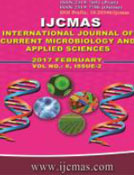


 National Academy of Agricultural Sciences (NAAS)
National Academy of Agricultural Sciences (NAAS)

|
PRINT ISSN : 2319-7692
Online ISSN : 2319-7706 Issues : 12 per year Publisher : Excellent Publishers Email : editorijcmas@gmail.com / submit@ijcmas.com Editor-in-chief: Dr.M.Prakash Index Copernicus ICV 2018: 95.39 NAAS RATING 2020: 5.38 |
Sporotrichosis is a sub-acute or chronic granulomatous fungal infection involving primarily the skin and subcutaneous tissue with neighbouring lymphatics caused by a dimorphic fungus Sporothrix schenckii. The disease is worldwide in distribution. In India sporotrichosis is endemic in the Sub-Himalayan region; stretching from West Bengal, Assam and Manipur in the North East and Himachal Pradesh in the North West. In comparison to extensive studies at far eastern states of Assam and Manipur, till now very few studies are there in Siliguri (a small Sub division at the foothills of Himalaya within District Darjeeling of West Bengal) and surrounding areas. Therefore a retrospective study has been carried out over a period of nine years since 1st Dec, 2007 up to 30th Nov, 2016 on 150 patients with skin lesions attending Sharma’s Skin Foundation at Siliguri. All the samples from skin lesions were tested at “The Microbes pathology lab”, Siliguri. Out of 40 culture positive cases interestingly 16 (40%) of patients were permanent inhabitants of Siliguri and neighbouring plains like Naxalbari, Phansidewa, Jalpaiguri, Haldibari etc., not migrants from the surrounding hilly areas. Twenty four (60%) of the patients are belonged to hilly area e.g., Sikkim, Darjeeling, Kalimpong, Kurseong and Mirik. Lymphocutaneous variants were the predominant forms e.g. 26 (65%) followed by fixed cutaneous variants 13 (34%) and in 1% there were disseminated cutaneouos lesions scattered all over the chest, arms and thighs. One case had been presented as Pyoderma gangrenosa, a moribant case cured by giving IV amphotericin B. The chances of isolating Sporothrix schenckii from pus samples and wound swabs from the lesions were very good giving confirmed diagnosis in 10 to 14 days. Some of the positive samples 2 (5%) were sent to referral centres at Delhi for serology by Latex agglutination tests giving positive results with significant antibody titres. All the patients were successfully treated with saturated solution of potassium iodide. The cases reported here indicate that the disease is prevalent in Siliguri with surrounding plains and hills. It may be another emerging endemic area in the Sub-Himalayan belt.
 |
 |
 |
 |
 |